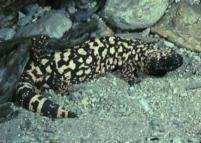

Genus: Heloderma
Species: suspectum cinetum

The Banded Gila Monster is very shy but can strike back very quickly, with painful results. It is a subspecies of the Gila Monster (Heloderma suspectum), and is one of two venomous types of lizard in the world.
They are pink, orange and red. Four or five black bands with spots in them run around the body. The tail is also banded. Their heads are spotted with black around their eyes and mouth. Their patterns are really amazing because their colors send out a warning to any predators that they are venomous.
The Banded Gila Monster can get to be 2 feet long and can weigh up to 3 pounds. They have a big head, fat body, and a thick, short tail. They have short legs with average sized claws for a lizard of its size. Its skin is dry because it lives in the desert and can't afford to lose fluids. The texture is bumpy.
The gila monster hunts at day, but is hardly ever seen by people because it is so shy. The Banded Gila Monster is mainly found in the Mojave Desert. It is named for the Gila River Basin which is found in the southwestern United States
The Gila Monster mates in July and lays its eggs a few weeks later. They lay 3 to 15 eggs in a hole then cover them with sand. They hatch in 28 to 30 days. The babies are 3.5 to 4.5 inches long. They can survive on their own after they hatch. When they are 1 to 3 years old they are adult size.
We don't know much about the Banded Gila Monster, because it spends most of its life underground in burrows. It is most active in the spring time. It is active during the day and comes out in the morning, because it gets too hot in the afternoon. The Banded Gila Monster spends most of its life alone, but they do gather together during mating season.
This amazing lizard has such good hearing and vision that it can lay inside its burrow until it is safe to come out. When it is under trees or bushes it is camouflaged and when it is not, its red, pink, orange, and black colors are a warning to predators. It stores fat in its tail and its body. It can survive on its fat, or stored energy, for about three months. It has very strong jaws and venom that can be released through its bottom teeth. The bottom teeth are large and have grooves for the venom to flow through them. The Gila Monsters venom is about as strong as a Western Diamondback Rattlesnake. When it bites you it chews as it bites and that is how the venom gets into you. You don't usually die because it only injects a small amount of venom. When it bites you its jaws are hard to get off because they are very strong. Scientists are testing the venom to see if it can be used to treat diabetes.
The Gila Monster eats bird and reptile eggs, young rodents and small reptiles, baby birds, rabbits and hares. They can eat huge amounts of food at one time and they can store fat in their tails and their bodies.
The Gila Monster is a predator. Sometimes it digs its own holes and some times it uses holes dug by other animals for their burrows. They live in heavy brush, or rocky brushy wash bed or canyon bottoms.
The Gila Monster is not endangered. It is listed in Conservation on International Trade in Endangered Species (CITES), Appendix II. CITES lists species that can become endangered. Collectors for the pet trade can only catch a certain amount of lizards and need permits to do that. The International Union for the Conservation of Nature (IUCN) lists them as vulnerable so you cant collect them or own them without a permit. Many people are making farms and destroying their habitat.
Mike D. 2001
Bibliography:
"Gila Monster Information", http://hrcweb.lv-hrc.nevada.edu/mbm/reptiles/gilatext.htm, (Nov 2000).
"Gila Monster (Desert USA)", http://desertusa.com/sep97/du_gilamonster.html, (Nov 2000).
"General Information", http://www.drseward.com/geninfo.htm, (Nov 2000).
"Behavior", http://drseward.com/behavior.htm, (Nov 2000).
"Hibernation", http://drseward.com/hibernat.htm, (Nov 2000).
"Endangered Species", http://www.nwi.org/Treaties/CITESsummary.html, (Mar 2001).
For a great
educational website on venomous animals and toxins,
visit:
http://www.calacademy.org/exhibits/venoms/education_resources